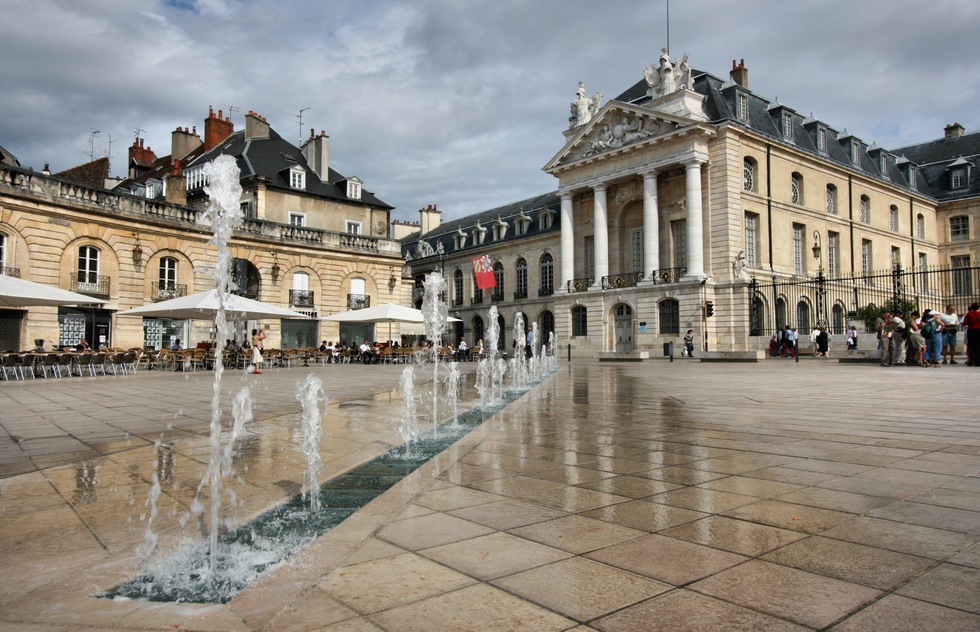Dijon was a backwater when the French Revolution occurred, a happy twist of fate because it meant that its churches, palaces, and mansions were largely undisturbed at a time when marauding masses were damaging and destroying historic structures in other French cities. And you’ll learn a lot about the fascinating history of the city by looking at these buildings—which range from medieval half-timbered houses to palaces—if you have the right interpreter. A gent who goes by the name of Bertrand on Airbandb/Experiences is an excellent tour guide (at $17/person); or you can pick up the surprisingly engaging audio walking tour from the Tourist Board (see above; 10€).
On either tour, you’ll definitely spend time at the grand Palais des Ducs et des États de Bourgogne, which was once seat of government for an empire that stretched all the way into today’s Holland and Belgium. Its oldest section was constructed in the 14th and 15th centuries. Today the complex, set around two courtyards, is capped with mansard roofs (gray-tile gambrel roofs, popular in the 17th-century, like those you see in parts of the Louvre and on chateaux across France). The newer section is the Palais des États de Bourgogne, constructed in the 17th and 18th centuries for the Burgundian parliament; check out the Chapelle des Élus (free access via the tourist office), which dates from 1738 and was designed by Jacques Gabriel, Louis XV’s architect. Today the palace is la mairie (the town hall); all of its newer section and much of its older section are reserved for the municipal government and not open to the public. However, fabulous views can be had from the top of Tour Philippe le Bon (316 steps; 5€ adults; days and times vary; check with the tourist office; http://destinationdijon.com/visites/la-montee-de-la-tour-philippe-le-bon).
Walking tours also always head into Dijon’s Medieval Quarter to see the extravagant 16th and 17th century hôtels particuliers (private mansions), some of which have colorful, geometrically-patterned roof tiles, a practice that dates back to the 14th century and is found throughout the region. Gothic cathedral Notre-Dame de Dijon is always a stop, too, mostly so that participants can rub an owl gargoyle on the side of the church for luck (on Rue de la Chouette). Just across from the owl (which looks like just a lump today from all the rubbing) is Maison Milliere, a perfectly preserved half-timbered cottage from 1483 that had a starring role in Gerard Depardieu's film version of Cyrano de Bergerac (1990).
The Musée Archéologique, 5 rue du Docteur Maret (https://archeologie.dijon.fr; tel. 03-80-48-83-70), housed in a medieval abbey, contains finds from the area, including the abbey itself. Admission is free, and it’s open Wednesday to Monday 9am to 12:30pm and 2 to 6pm; from November to March, the museum is open Wednesday, Saturday, and Sunday. It can be skipped if you’re short on time.
A medieval nunnery, Monastère des Bernardines, 15–17 rue Ste-Anne ([tel] 03-80-48-80-90), is home to two museums. The chapel holds the Musée d’Arts Sacrés (https://art-sacre.dijon.fr), devoted to art from regional churches, and the cloister contains the Musée de la Vie Bourguignonne (https://vie-bourgignonne.dijon.fr), which exhibits folkloric costumes, farm implements, and some 19th- and early-20th-century storefronts from Dijon’s center. Admission is free to both museums (Wed–Mon 9:30am–12:30pm and 2–6pm).
The Musée Archéologique, 5 rue du Docteur Maret (https://archeologie.dijon.fr; tel. 03-80-48-83-70), housed in a medieval abbey, contains finds from the area, including the abbey itself. Admission is free, and it’s open Wednesday to Monday 9am to 12:30pm and 2 to 6pm; from November to March, the museum is open Wednesday, Saturday, and Sunday.
A medieval nunnery, L’Ancien Couvent des Bernardines, 17 rue Ste-Anne (tel. 03-80-48-80-90), is home to two museums. The chapel holds the Musée d’Arts Sacrés (https://art-sacre.dijon.fr), devoted to art from regional churches, and the cloister contains the Musée de la Vie Bourguignonne (https://vie-bourguignonne.dijon.fr), which exhibits folkloric costumes, farm implements, and some 19th- and early-20th-century storefronts from Dijon’s center. Admission is free to both museums (Wed–Mon 9:30am–12:30pm and 2–6pm).
Note: This information was accurate when it was published, but can change without notice. Please be sure to confirm all rates and details directly with the companies in question before planning your trip.









